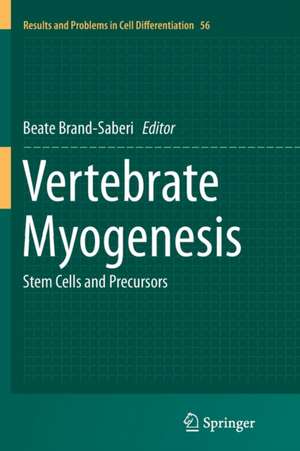Vertebrate Myogenesis: Stem Cells and Precursors: Results and Problems in Cell Differentiation, cartea 56
Editat de Beate Brand-Saberien Limba Engleză Paperback – 23 aug 2016
With an eye to the human patient, encouraging results have been generated that identify parallels between embryonic myogenesis and regenerating myofibers due to common regulatory molecules. On the other hand, both processes differ considerably in quality and complexity of the processes employed. Interestingly, the heterogeneity in embryonic sources from which skeletal muscle groups in the vertebrate including the human body take origin is paralleled by differences in their susceptibility to particular muscle dystrophies as well as by the characteristics of the satellite cells involved in regeneration. The progress that has been made in the field of muscle stem cell biology, with special focus on the satellite cells, is outlined in this book by experts in the field. The authors review recent insights of the heterogeneous nature of these satellite cells regarding their gene signatures and regeneration potential. Furthermore, an improved understanding of muscle stem cells seems only possible when we study the impact of the cell environment on efficient stem cell replacement therapies for muscular dystrophies, putting embryological findings from different vertebrate classes and stem cell approaches into context.
| Toate formatele și edițiile | Preț | Express |
|---|---|---|
| Paperback (2) | 942.31 lei 6-8 săpt. | |
| Springer Berlin, Heidelberg – 23 aug 2016 | 942.31 lei 6-8 săpt. | |
| Springer Berlin, Heidelberg – 15 dec 2010 | 1033.67 lei 38-44 zile | |
| Hardback (2) | 948.29 lei 6-8 săpt. | |
| Springer Berlin, Heidelberg – 3 noi 2014 | 948.29 lei 6-8 săpt. | |
| Springer Berlin, Heidelberg – 13 iun 2002 | 1222.49 lei 6-8 săpt. |
Din seria Results and Problems in Cell Differentiation
- 18%
 Preț: 1391.73 lei
Preț: 1391.73 lei - 15%
 Preț: 597.16 lei
Preț: 597.16 lei -
 Preț: 387.96 lei
Preț: 387.96 lei - 5%
 Preț: 373.33 lei
Preț: 373.33 lei -
 Preț: 382.18 lei
Preț: 382.18 lei -
 Preț: 385.08 lei
Preț: 385.08 lei - 15%
 Preț: 644.82 lei
Preț: 644.82 lei - 15%
 Preț: 634.00 lei
Preț: 634.00 lei -
 Preț: 387.20 lei
Preț: 387.20 lei -
 Preț: 387.75 lei
Preț: 387.75 lei - 15%
 Preț: 643.34 lei
Preț: 643.34 lei -
 Preț: 382.18 lei
Preț: 382.18 lei -
 Preț: 394.71 lei
Preț: 394.71 lei -
 Preț: 390.08 lei
Preț: 390.08 lei -
 Preț: 381.43 lei
Preț: 381.43 lei -
 Preț: 385.47 lei
Preț: 385.47 lei -
 Preț: 385.47 lei
Preț: 385.47 lei -
 Preț: 391.22 lei
Preț: 391.22 lei - 18%
 Preț: 1227.04 lei
Preț: 1227.04 lei - 20%
 Preț: 561.68 lei
Preț: 561.68 lei - 5%
 Preț: 1418.27 lei
Preț: 1418.27 lei -
 Preț: 386.00 lei
Preț: 386.00 lei -
 Preț: 377.95 lei
Preț: 377.95 lei -
 Preț: 391.61 lei
Preț: 391.61 lei -
 Preț: 388.52 lei
Preț: 388.52 lei - 18%
 Preț: 1380.63 lei
Preț: 1380.63 lei - 15%
 Preț: 639.25 lei
Preț: 639.25 lei - 18%
 Preț: 1220.12 lei
Preț: 1220.12 lei - 15%
 Preț: 642.51 lei
Preț: 642.51 lei - 15%
 Preț: 640.37 lei
Preț: 640.37 lei - 18%
 Preț: 1222.49 lei
Preț: 1222.49 lei - 18%
 Preț: 946.41 lei
Preț: 946.41 lei -
 Preț: 387.38 lei
Preț: 387.38 lei - 18%
 Preț: 1228.47 lei
Preț: 1228.47 lei - 15%
 Preț: 642.51 lei
Preț: 642.51 lei - 18%
 Preț: 1663.00 lei
Preț: 1663.00 lei - 18%
 Preț: 1225.62 lei
Preț: 1225.62 lei
Preț: 942.31 lei
Preț vechi: 1149.16 lei
-18% Nou
Puncte Express: 1413
Preț estimativ în valută:
180.31€ • 188.93$ • 149.06£
180.31€ • 188.93$ • 149.06£
Carte tipărită la comandă
Livrare economică 12-26 aprilie
Preluare comenzi: 021 569.72.76
Specificații
ISBN-13: 9783662513187
ISBN-10: 3662513188
Pagini: 248
Ilustrații: VI, 242 p. 25 illus., 23 illus. in color.
Dimensiuni: 155 x 235 x 13 mm
Greutate: 0.35 kg
Ediția:Softcover reprint of the original 1st ed. 2015
Editura: Springer Berlin, Heidelberg
Colecția Springer
Seria Results and Problems in Cell Differentiation
Locul publicării:Berlin, Heidelberg, Germany
ISBN-10: 3662513188
Pagini: 248
Ilustrații: VI, 242 p. 25 illus., 23 illus. in color.
Dimensiuni: 155 x 235 x 13 mm
Greutate: 0.35 kg
Ediția:Softcover reprint of the original 1st ed. 2015
Editura: Springer Berlin, Heidelberg
Colecția Springer
Seria Results and Problems in Cell Differentiation
Locul publicării:Berlin, Heidelberg, Germany
Cuprins
Recruitment of skeletal muscle progenitors to secondary sites: A role for CXCR4/SDF-1 signaling in skeletal muscle development.- Hypaxial muscle - controversial classification and controversial data? Skeletal Myogenesis in the Zebrafish and its Implications for Muscle Disease Modeling.- Mechanisms of Myogenic Specification and Patterning.- The avian embryo as a model system for skeletal myogenesis.- Head Muscle Development.- The lateral plate mesoderm – a novel source of skeletal muscle.- Regulation of skeletal muscle development and disease by microRNAs.- Adult skeletal muscle stem cells.- Dormancy and quiescence of skeletal muscle stem cells.
Textul de pe ultima copertă
This book addresses the differentiation control of skeletal muscle in different locations of the vertebrate body. Particular attention is paid to novel regulatory molecules and signals as well as to the heterogeneity of origin that have revealed a developmental overlap between skeletal and cardiac muscle. Different functional muscle groups are the product of the evolution of the vertebrate classes, making a phylogenetic comparison worthwhile for understanding the role of muscle stem cells and precursors in myogenesis. New insights into the hierarchy of transcription factors, particularly in the context of these different muscle groups come from detailed investigations of the spatio-temporal and regulatory relationships derived from mouse and zebrafish genetics and avian microsurgery. Importantly, epigenetic mechanisms that have surfaced recently, in particular the role of MyomiRs, are also surveyed.
Regarding human patients, encouraging results have been generated that identify parallels between embryonic myogenesis and regenerating myofibers that share regulatory molecules. Interestingly, the heterogeneity in embryonic origins of skeletal muscle groups in the vertebrate including humans is paralleled by their different susceptibility to types of muscle dystrophies. The progress that has been made in the field of muscle stem cell biology, especially on satellite cells, is outlined in this book by experts in the field. The authors review recent insights of the heterogeneous nature of these satellite cells regarding their gene signatures and regeneration potential. An improved understanding of muscle stem cells seems only possible with a view to the cell environment , putting embryological and molecular findings from different vertebrate classes and stem cell approaches into context.
Regarding human patients, encouraging results have been generated that identify parallels between embryonic myogenesis and regenerating myofibers that share regulatory molecules. Interestingly, the heterogeneity in embryonic origins of skeletal muscle groups in the vertebrate including humans is paralleled by their different susceptibility to types of muscle dystrophies. The progress that has been made in the field of muscle stem cell biology, especially on satellite cells, is outlined in this book by experts in the field. The authors review recent insights of the heterogeneous nature of these satellite cells regarding their gene signatures and regeneration potential. An improved understanding of muscle stem cells seems only possible with a view to the cell environment , putting embryological and molecular findings from different vertebrate classes and stem cell approaches into context.
Caracteristici
Gives an overview of the latest findings on skeletal muscle development Includes recent progress in muscle stem cell biology Written by international experts in the field Includes supplementary material: sn.pub/extras








